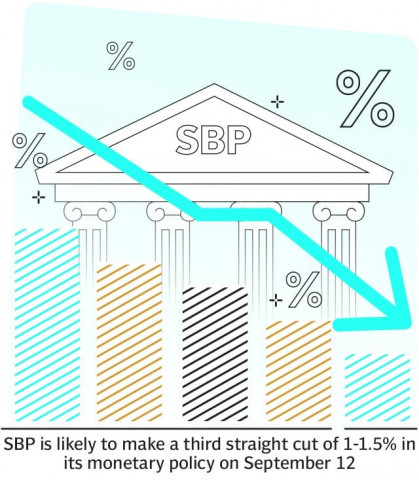SBP likely to cut policy rate again
Experts predict cautious approach to prevent currency depreciation

In its upcoming monetary policy meeting scheduled for Friday, September 12, Pakistan's central bank is widely anticipated to make a third consecutive cut in its key policy rate. The reduction, expected to be in the range of 1% to 1.5%, follows a decline in inflation to single digits in August and aims to support economic activity in the fiscal year 2024-25.
There is potential for a larger cut given the significant gap between the State Bank of Pakistan's (SBP) current policy rate and the latest inflation reading, which results in a real interest rate of 10-11%. Historically, Pakistan has maintained an average real interest rate of 3-5% to protect against unexpected inflation surges.
Saad Hanif, Head of Research at Ismail Iqbal Securities, believes the SBP will take a cautious approach, opting for gradual rather than aggressive cuts. He notes two primary reasons for this: first, the bank's desire to maintain a tight monetary policy in line with the International Monetary Fund (IMF) recommendations as Pakistan seeks a $7 billion loan programme, expected in September. Second, a larger rate cut could lead to an unwanted depletion of foreign exchange reserves, potentially weakening the rupee, which has remained stable at Rs278-279/$ for over five months.
Hanif predicts the central bank will reduce the policy rate by 100 basis points (1 percentage point) on Friday. The SBP previously cut the rate by 250 basis points over June and July, bringing it down to 19.5% after keeping it at a record high of 22% for one year.
Hanif also warned that a steeper cut could prompt businesses to increase bank borrowing for expansion, which may drive demand for imports and quickly erode the country's low foreign exchange reserves. This could result in rupee depreciation to Rs295/$ by the end of the current fiscal year, compared to the current rate of Rs278-279/$.
Tahir Abbas, Head of Research at Arif Habib Limited, anticipates a 150 basis point cut, bringing the policy rate down to 18%, a level last seen in February 2023. He cites several factors supporting this expectation, including the return of inflation to single digits after three years, improved foreign exchange reserves, controlled current account deficits, and rising large-scale manufacturing (LSM) output. The government's focus on fostering economic growth further reinforces the likelihood of a 150 basis point reduction.
Pakistan reached a staff-level agreement with the IMF in July 2024, and official approval from the executive board is expected soon. "The IMF's commitment to fostering disinflation supports our expectation of continued monetary easing," Abbas noted in a commentary, adding that a rate reduction aligns with the IMF's policy stance and ongoing efforts to stabilise the economy.
A poll conducted by Abbas' research house revealed that 57.1% of participants expect a 150 basis point cut. Meanwhile, 21.4% predict a 200 basis point reduction, 10.7% foresee a 100 basis point cut, and 3.6% anticipate a 250 basis point decrease.
Similarly, Shankar Talreja, Deputy Head of Research at Topline Securities, reported that 59% of poll participants expect the SBP to reduce the rate by 150 basis points, 19% foresee a 200 basis point cut, and 5% predict more than 200 basis points. Meanwhile, 13% expect a 100 basis point reduction, and 2% expect a 50 basis point cut.
"We believe larger rate cut expectations in the upcoming monetary policy meeting are driven by August 2024's single-digit inflation reading of 9.6%, which is expected to remain below 8% in September 2024," Talreja said. "We share the view that the SBP will announce a rate cut of 150 basis points, compared to the 100 basis point cut in the last monetary policy meeting in July."



















COMMENTS
Comments are moderated and generally will be posted if they are on-topic and not abusive.
For more information, please see our Comments FAQ